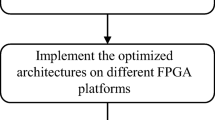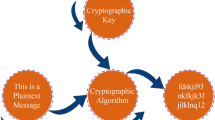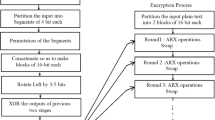Abstract
The internet of things (IoT) is now an in-demand technology that has been adopted in various applications and includes various embedded devices, sensors and other objects connected to the Internet. Due to the rapid development of this technology, it covers a significant portion of the research interests nowadays. IoT devices are typically designed for collecting different types of data from various sources and transmitting them in digitized form. However, data security is the burning issue in the IoT technology, which can broadly impact the privacy of crucial data. In this regard, a new lightweight encryption method called LRBC has been proposed in this work for resource constraint IoT devices which can provide data security at the sensing level. The LRBC has used the structural advantages of both substitution–permutation network (SPN) and Feistel structure together to achieve better security. Furthermore, the proposed method has been tested on NEXYS 4 DDR FPGA (Artix-7) trainer kit and implemented for application specific integrated circuit (ASIC) chip on TSMC 65 nm technology. The proposed algorithm consumes very less power of 11.40 μW and occupies a 258.9 GE (Gate Equivalent) area. Besides, a thorough security analysis shows that the proposed scheme ensures high security against various attacks with robustness. Moreover, the average avalanche effect of LRBC is found to be 58% and 55.75% concerning plaintext and key, respectively.












Similar content being viewed by others
References
Abdelhalim M, El-Mahallawy M, Ayyad M, Elhennawy A (2012) Design and Implementation of an Encryption Algorithm for use in RFID System. Int J RFID Security Cryptogr (IJRFIDSC) 1(1/2):15–22
Albrecht MR, Driessen B, Kavun EB, Leander G, Paar C, Yalçın T (2014) Block ciphers-focus on the linear layer (feat. PRIDE). In: Proc of international cryptology conference. Springer, Berlin, Heidelberg, pp 57–76
Andrey B, Knudsen LR, Leander G, Paar C, Poschmann A, Robshaw MJB, Seurin Y, Vikkelsoe C (2007) PRESENT: an ultra-lightweight block cipher. Proceedings of international workshop on cryptographic hardware and embedded systems. Springer, Berlin, pp 450–466
Banik S, Bogdanov A, Isobe T, Shibutani K, Hiwatari H, Akishita T, Regazzoni F (2014) Midori: a block cipher for low energy. Proc of international conference on the theory and application of cryptology and information security. Springer, Berlin, pp 411–436
Banik S, Pandey SK, Peyrin T, Sasaki Y, Sim SM, Todo Y (2017) GIFT: a small PRESENT. Proc Int Conf Cryptogr Hardw Embedded Syst Springer Cham 2017:321–345
Bansod G, Pisharoty N, Patil A (2017) BORON: an ultra-lightweight and low power encryption design for pervasive computing. Front Inf Technol Electr Eng 18(3):317–331
Beaulieu R, Treatman-Clark S, Shors D, Weeks B, Smith J, Wingers L (2015) The SIMON and SPECK lightweight block ciphers. Proc of 52nd conference on design automation (DAC). ACM/EDAC/IEEE, San Francisco, pp 1–6
Bogdanov A, Knežević M, Leander G, Toz D, Varıcı K, Verbauwhede I (2011) SPONGENT: a lightweight hash function. Proc of international workshop on cryptographic hardware and embedded systems. Springer, Berlin, pp 312–325
Borghoff J, Canteaut A, Güneysu T, Kavun EB, Knezevic M, Knud-sen LR, Leander G, Nikov V, Paar C, Rechberger C, Rombouts P, Thomsen SS, Yalc T (2012) PRINCE—a low-latency block cipher for pervasive computing applications. In: Proc of ASIACRYPT 2012, Springer, pp 208–225
De Canniere C, Dunkelman O, Knežević M (2009) KATAN and KTANTAN—a family of small and efficient hardware-oriented block ciphers. Proc of cryptographic hardware and embedded systems-CHES 2009. Springer, Berlin, pp 272–288
Eisenbarth T, Kumar S, Paar C, Poschmann A, Uhsadel L (2007) A survey of lightweight-cryptography implementations. IEEE Des Test Comput 24(6):522–533
Guo J, Peyrin T, Poschmann A (2011a) The PHOTON family of lightweight hash functions. Proc Annu Cryptol Conf Springer Berlin Heidelberg 2011:222–239
Guo J, Peyrin T, Poschmann A, Robshaw M (2011b) The LED block cipher. Proc of cryptographic hardware and embedded systems-CHES 2011. Springer, Berlin, pp 326–341
Hamalainen P, Alho T, Hannikainen M, Hamalainen TD (2006) Design and implementation of low-area and low-power AES encryption hardware core. In: Proc of 9th EUROMICRO conference on digital system design: architectures, methods and tools, DSD 2006, IEEE, pp 577–583
Heys HM (2002) A tutorial on linear and differential cryptanalysis. Cryptologia 26(3):189–221
Hong D, Lee JK, Kim DC, Kwon D, Ryu KH, Lee DG (2013) LEA: a 128-bit block cipher for fast encryption on common processors. Int Workshop Inf Secur Appl Springer Cham 2013:3–27
Hui TK, Sherratt RS, Sanchez DD (2017) Major requirements for building smart homes in smart cities based on internet of things technologies. Future Gen Comput Syst 76:358–369
Jagdish P, Bansod G, Kant KS (2017) LiCi: a new ultra-lightweight block cipher. In: Emerging trends and innovation in ICT (ICEI), international conference on IEEE, pp 40–45
Karakoç F, Demirci H, Harmancı AE (2013) ITUbee: a software oriented lightweight block cipher. Proc of international workshop on lightweight cryptography for security and privacy. Springer, Berlin, pp 16–27
Karakoç F, Demirci H, Harmancı AE (2015) AKF: a key alternating Feistel scheme for lightweight cipher designs. Inf Process Lett 115(2):359–367
Kim S, Lee I (2018) IoT device security based on proxy re-encryption. Journal of Ambient Intelligence and Humanized Computing 9(4):1267–1273
Koo B, Roh D, Kim H, Jung Y, Lee DG, Kwon D (2017) CHAM: a family of lightweight block ciphers for resource-constrained devices. Proc Int Conf Inf Secur Cryptol Springer Cham 2017:3–25
Lang L, Liu B, Wang H (2016) QTL: a new ultra-lightweight block cipher. Microprocess Microsyst Elsevier 45:45–55
Lars K, Leander G, Poschmann A, Robshaw MJB (2010) PRINTcipher: a block cipher for IC-printing. Proc of international workshop on cryptographic hardware and embedded systems. Springer, Berlin, pp 16–32
Li L, Liu B, Zhou Y, Zou Y (2018) SFN: a new lightweight block cipher. Microprocess Microsyst 60:138–150
Majumdar A, Debnath T, Sood SK, Baishnab KL (2018a) Kyasanur forest disease classification framework using novel extremal optimization tuned neural network in fog computing environment. J Med Syst 42(10):187
Majumdar A, Laskar NM, Biswas A, Sood SK, Baishnab KL (2018b) Energy efficient e-healthcare framework using HWPSO-based clustering approach. J Intell Fuzzy Syst 36(5):1–13
Majumdar A, Biswas A, Baishnab KL, Sood SK (2019) DNA based cloud storage security framework using fuzzy decision making technique. KSII Trans Internet Inf Syst 13(7):3794–3820
Nalla V, Sahu RA, Saraswat V (2016) Differential fault attack on SIMECK. In: Proc of the 3rd workshop on cryptography and security in computing systems, ACM, pp 45–48
Nikova S, Rijmen V, Schläffer M (2011) Secure hardware implementation of nonlinear functions in the presence of glitches. J Cryptol 24(2):292–321
Ray PP (2017) Internet of things for smart agriculture: technologies, practices and future direction. J Ambient Intell Smart Environ 9(4):395–420
Sadeghi S, Bagheri N, Abdelraheem MA (2017) Cryptanalysis of reduced QTL block cipher. Microprocess Microsyst 52:34–48
Shibutani K, Isobe T, Hiwatari H, Mitsuda A, Akishita T, Shirai T (2011) Piccolo: an ultra-lightweight blockcipher. Proc Int Workshop Cryptogr Hardw Embedded Syst Springer Berlin Heidelberg 2011:342–357
Shirai T, Shibutani K, Akishita T, Moriai S, Iwata T (2007) The 128-bit blockcipher CLEFIA. Proc of international workshop on fast software encryption. Springer, Berlin, pp 181–195
Singh S, Sharma PK, Moon SY, Park JH (2017) Advanced lightweight encryption algorithms for IoT devices: survey, challenges and solutions. J Ambient Intell Human Comput 1–18
Suzaki T, Minematsu K, Morioka S, Kobayashi E (2011) Twine: a lightweight, versatile block cipher. In: ECRYPT workshop on lightweight cryptography, pp 146–169
Wei Y, Xu P, Rong Y (2019) Related-key impossible differential cryptanalysis on lightweight cipher TWINE. J Ambient Intell Human Comput 10(2):509–517
Wentao Z, Bao Z, Lin D, Rijmen V, Yang B, Verbauwhede I (2015) RECTANGLE: a bit-slice lightweight block cipher suitable for multiple platforms. Sci China Inf Sci Springer Verlag Berlin Heidelberg 58(12):1–15
Wheeler DJ, Needham RM (1994) TEA, a tiny encryption algorithm. Proc of international workshop on fast software encryption. Springer, Berlin, pp 363–366
Yang G, Zhu B, Suder V, Aagaard MD, Gong G (2015) The simeck family of lightweight block ciphers. Proc of international workshop on cryptographic hardware and embedded systems. Springer, Berlin, pp 307–329
Zhang W, Bao Z, Lin D, Rijmen V, Yang B, Verbauwhede I (2015) RECTANGLE: a bit-slice lightweight block cipher suitable for multiple platforms. Sci China Inf Sci 58(12):1–5
Zhou G, Liu Z, Shu W, Bao T, Mao L, Wu D (2017) Smart savings on private car pooling based on internet of vehicles. J Intell Fuzzy Syst 32(5):3785–3796
Acknowledgements
This publication is an outcome of the R&D work undertaken project under the Visvesvaraya Ph.D Scheme of Ministry of Electronics & Information Technology, Government of India, being implemented by Digital India Corporation.
Author information
Authors and Affiliations
Corresponding author
Ethics declarations
Conflict of interest
The authors have no conflict of interests to declare.
Ethical approval
This article does not contain any studies with human participants or animals performed by any of the authors.
Additional information
Publisher's Note
Springer Nature remains neutral with regard to jurisdictional claims in published maps and institutional affiliations.
Rights and permissions
About this article
Cite this article
Biswas, A., Majumdar, A., Nath, S. et al. LRBC: a lightweight block cipher design for resource constrained IoT devices. J Ambient Intell Human Comput 14, 5773–5787 (2023). https://doi.org/10.1007/s12652-020-01694-9
Received:
Accepted:
Published:
Issue Date:
DOI: https://doi.org/10.1007/s12652-020-01694-9




